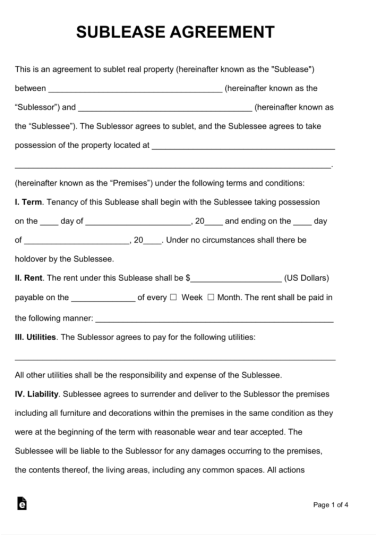When you take a hiatus from your lease, someone else has to take over your payments. This is called a sublease. The party who is subleasing may or may not be known to you, and in the event of a problem, you are the one liable.
In order to instill accountability on the part of your subletter, and to put your leasing company at ease, have the subletter sign a sublease contract. A sublease contract serves to establish all of the same rules and guidelines that your leasing company has you sign to on your initial lease.
Free Sublease Agreement in Word Format
This article provides a beginners guide to writing a sublease contract. Learn all the ins and outs of the necessary legal jargon you need to satisfy your leasing company.
Guide to Writing a Sublease Contract
Maybe you’re a snowbird, maybe you have to temporarily move for work, or maybe you are going home from college for the summer. Unless you have stockpiles of money lying around, subleasing is the only way to get out of rent payments when you are away from your rental.
Subleasing allows you the option to go on trips for extended periods of time without paying rent for a property you aren’t using. Things get more complicated, though, when a subletter comes into the mix.
It doesn’t matter if you are renting to a college friend, a stranger, or your Mom-make a sublease contract. If you are lucky, you can sublease to someone you know, like a friend or acquaintance. Having an established relationship instills strong accountability on the part of your renter.
Most subleasing agreements are the initiation of the relationship, and therefore, you must vet accountability. Accidents happen and it is even more difficult to confront a friend or family member about paying for damages than it is to confront a stranger.
As the one subletting your property, you act in the role of your leasing agency, and the subleaser is your tenant. As any landlord in an urban area knows, it can be tough to find good renters. So, make sure you interview your tenants thoroughly and scrupulously.
Important Facts about Subleasing
The first thing you need to do is ask your rental company if they allow tenants to sublease. Going around your rental companies back is a bad idea and can land you with an eviction. If you are subletting a commercial property, draft your sublease contract with an attorney.
If you are subleasing a residential property — as most renters are — all you need is the go-ahead from your landlord to make up a contract. When you find a suitable candidate your landlord must give their permission to move forward with the contract.
The landlord, tenant, and subletter are the three necessary signatures for a valid sublease agreement. When all the parties in the sublease agreement sign the contract, it is legally valid.
If you want to increase the chance of your landlord agreeing to your subtenant, give your landlord their credit report, recent income statement, and a good reference from a past landlord.
If you want to know the right things to ask for from your subletter, talk to your landlord.
This shows your landlord that, not only your subtenant is reliable, but that you are a trustworthy arbiter.
Subleases are temporary by definition. If you are moving out of your apartment, but you want to move out before your lease is up, you are not subleasing. That arrangement requires a lease assignment contract.
Vetting Potential Subtenants
When you sublease to a third-party you are still responsible for all of the things you sign to in your lease. The subletter does not take you off the hook with your landlord. You want to find a subtenant that is trustworthy and responsible.
Common courtesy is a great place to start with vetting subtenants. If your subtenant turns out to be a rude, loud, discourteous person, you come back home to neighbors that hate you.
For example, if you live in a city apartment building near other families, you might want to avoid smokers or party-animals. Not that party-animals don’t pay rent-they might disturb those who live around you.
In the event of something needing a repair, like a sink or a toilet, your subletter must approach you, then you must approach your landlord. In the event of damage to the apartment, your landlord still takes it out of your security deposit. So, you need a security deposit from your subtenant.
Make sure, in your initial subtenant interview, that they are able to pay an upfront security deposit equal to that of your own. This one is non-negotiable. Your agreement is already delicate enough having two degrees of separation between the resident and the landlord.
If they can’t pay, they can’t stay — end of story.
Handling Security Deposits and Move-in Statements
Each state has different guidelines and regulations for how security deposits must be handled. In some states, you must pay interest on a security deposit. In other states, the landlord must hold a security deposit from a subletter.
In a few states, it is illegal for a landlord to hold a security deposit of more than one month’s rent, so your subletter must pay it to you. The standard appropriate amount for a security deposit is one month’s worth of rent.
Upon receiving the security deposit and moving in, have your subletter provide a move-in condition report checklist. Do the same, so that you have proof of your agreement on the state of the property at the time you vacate.
This is also a way to protect you and your subtenant from lawsuit accusations by your landlord. There are some sleazy landlords out there, so make sure your subletter know their property rights.
Describe, in detail, the state of any wear, damage, or visible disturbance to the property. When both the checklists are complete, both parties sign each other’s documents.
Writing Your Sublease Contract
Contracts for a sublease are a little like a roommate contract except they are legally binding. A sublease contract, itself, is only two pages in length. It is easy enough to fill out using a sublease contract template but you must figure out what to fill in, first. Determine…
Basic Info
The three pieces of basic info at the top of your sublease contract are the names of each party, the date, and the address of the rental property.
Duration of Sublease
Specify for how long the sublease will last. This is called the lease term. Specify for how many months the lease term is, the date when it begins, and the date when it ends.
Rent Amount and Payment Process
Specify the monthly rent amount, and on what day it is due to you each month. Subletters pay rent directly to you, as the sublessor. The sublessor, then, pays the landlord, so give yourself a few days in case of delays.
Some states will not let you charge your subtenant more rent than your initial lease specifies. Most subleases are for the full amount of rent or up to a 30 percent discount.
Determine whether the rent is for a furnished sublease or unfurnished. Furnished property is more valuable than unfurnished, so it demands a higher rent.
If the rent is split between your subletter and yourself, you must continue to pay your share to the landlord each month. If your tenant stops paying, you have legal recourse to take, because of your contract. If you stop paying, your landlord has legal recourse to take because of the lease with your signature.
Make sure you include terms of penalty for late payments. Generally, sublessors charge a flat rate fee for rent that is paid past the due date. $50 is a standard fee for rent under $1,000 a month.
Security Deposit
Write a section to specify how much the sublessee pays for a security deposit. Also, describe the handling process, as dictated by law in your state.
For example, specify who will be holding it and for what reason the amount is set. Then, describe the terms of returning the security deposit to the subtenant. Specify the course of events before which you will return the security deposit, such as a final inspection.
Explain why security deposit money can be withheld, like lack-of-payment, late fees, or damage.
Permissions and Expenses
Include sections that outline the exact rules of the property and the rental. Is the subletter allowed to have overnight visitors? Do you allow smoking in the apartment?
Anything you neglect to include on your sublease agreement is not lawfully binding. If you say on your contract that they can’t smoke indoors, but they do and it starts a fire, you can sue them for negligence and breach of contract. If you don’t have it in writing, you have no recourse.
Also, determine how the subletter will contribute to monthly utilities, like electric, gas, water, and internet.
Specify that the subletter may not extend their sublease or re-sublease the property to anyone, for any reason. And include a fee for breaking any terms of the contract. This can be equal to the amount left to pay according to the contract terms.
All Three Parties Sign and Date
Both, you and your subletter sign each other’s copy of the contract and date next to your name. Take both contracts to your landlord to, also, sign both contracts. When both contracts have three signatures-your subletter, yourself, and your landlord-the agreement is legally binding. Make a photocopy of the contract for your landlord, and enjoy your trip!
Final Thoughts
The whole point of a sublease contract is to ensure that the right party is held legally liable for breaching the agreement. Of course, in a perfect world, you would not need a legally binding agreement, because everyone keeps their word and makes all the payments on time. But, while you are still in the real world, write up a contract before you sublet.





















